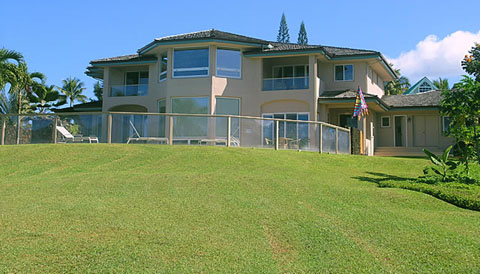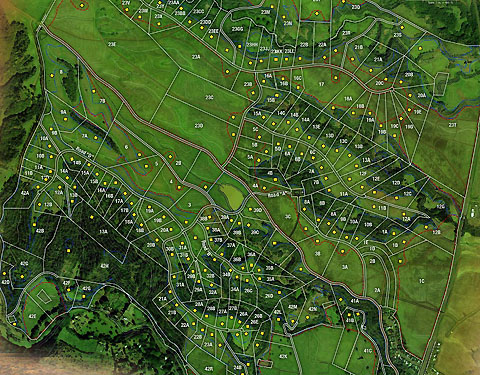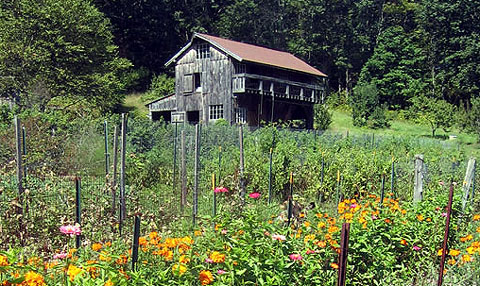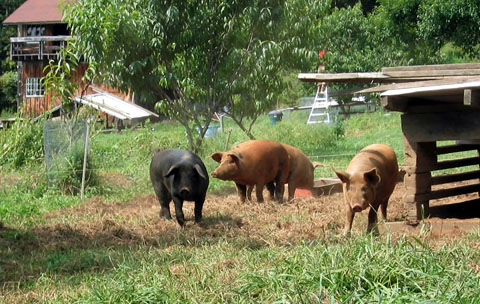by Rayne Raygush on 21 January 2007
Below is the test of a legal notice published today in The Garden Island News concerning unmarked burial sites found in Kealia. There is a 30-day deadline to contact DLNR-SHPD.
The historical significance of this area has not received much attention. Until now.....
Plantation Partners Kauai LLC plans to subdivide 2,000 acres in the Kealia Ahupuaa. These two parcels, Makee & Kumukumu, were formerly farmed by Lihue Plantation.
The developer comes before the Planning Commission on Tues., Jan 23rd (see below).
The SIGNIFICANCE of the Kealia Ahupuaa is decribed below (taken from proposed bike path signage).
A portion of proposed Kealia Bike Path Signage
Kealia Ahupua’a
The traditional Hawaiian economy was based on agricultural production, marine exploitation, animal husbandry, and wild plant and bird collecting. Coastal zones were utilized for marine resources, habitation, burials, and ceremonial structures often associated with fishing (Bennett 1931). Extended household groups settled in various ahupua`a, (i.e., smaller land divisions within a district) that customarily extended inland from the ocean. Ideally, this
situation allowed each ahupua`a to be self-sufficient by supplying needed resources from different environmental zones (Lyons 1875:111).
Kealia Ahupua’a controlled over 7000 acres including the well watered valley of Kapa’a Stream. This would have supported a stable population as evidenced by the auwai, irrigation ditches, found in the valley and the number of Land Commission Awards for loi, taro fields. A substantial number of named heiau, many destroyed by the sugar plantation, were described by Naiwi in 1885. They were:
Kawelomania Heiau – dedicated to shark god. Pookanaka Class.
Maile-huna Heiau - built by Chief Kiha, Lukahakona was its priest.
Mano Heiau - built by Chief Kiha, Lukahakona was its priest.
Noea-maka-li’i Heiau – built for the birth of chiefs.
Pa-hua Heiau - built by Chief Kiha, Lukahakona was its priest.
Pio-uka Heiau – unu types were built at a streams subject to ownership dispute by competing chiefs.
Pueo Heiau - built by Chief Kiha, Lukahakona was its priest.
Pu’u-koa Heiau – small unu type.
Una Heiau - built by Chief Kiha, Lukahakona was its priest.
Wai – ehu – o – malama - built by Kiha, Lukahakona was its priest.
|
Please share this information as appropriate.
LEGAL NOTICES
Public Notice
Notice is hereby given that human remains were documented during trench excavations at Land Commission Award locations 10628:1 and 10907:2, as part of a Phase II archeological inventory survey of the Kealanani Development Project located on Parcel 003 in Kealia, Kealia Ahupua'a, Kawaihau District, Island of Kaua'i, Hawaii [TMK: (4) 4-7-003:002 (Por.)]. The burials were discovered during trenching activities
of the respective land commission award locations which are depleted on the County of Kaua'i, Hawai'i, 4th Tax Division Tax Key Map 4-7-003:002.The unmarked burial sites were presumed to contain traditional Native Hawaiian remains and proper treatment shall occur in accordance with Chapter 6E, Revised Statutes, Section 43.5 regarding unmark ed grave sites. The final disposition of the burials shall be made by the State Historic Preservation Division -Burial
Sites Program in consultation with the Kaua'i/Ni'ihau Islands Burial Council.Interested persons please respond within 30 days of this notice to: DLNR-SHPD Cultural Programs Director at (808) 692--8021, Kakuhihewa Bldg. Room 555, 601 Kamokila Blvd., Kapolei, Hawaii 96707; Nancy McMahon, Kaua'i Island Archaeologist at (808) 742-7033, and/or Michael Dega at (808) 597-1182, 71-1 Kapiolani Blvd., Suite 975, Honolulu, Hawaii 96813, to discuss appropriate treatment
of these remains. Individuals responding must be able to adequately demonstrate lineal and/or cultural connection to the burials on the above referenced parcel at Kealia, Kaua'i.
(January 21, 24 & 25, 2007)
|
Please attend the January 23rd Planning Commission meeting at Lihu'e Civic Center, Moikeha Building, Meeting Rooms 2A-2B. Or write your concerns to the Planning Commission 4444 Rice Street, Lihu'e, Hawaii, 96766. FAXES can be sent to: (808) 241-6699.
Planning Commission Meeting
January 23, Tuesday
Kealia Kealanani Agricultural Subdivision
(S-2006-45 & S-2006-46)
Plantation Partners Kauai, LLC
Modification of Requirement/Condition
7:30am Subdivision Committee
9:00am Planning Commission
The County Planning Commission has already granted approval for the tentative subdivision of 2,021 acres of Agricultural and Open District land in Kealia mauka! But the land developer must still obtain a Declaratory Ruling from the State Land Use Commission (LUC) as to whether the proposed subdivision would be consistent with state-wide zoning laws that prevent the conversion of prime agricultural land to residential uses.
The land developer and the County’s planning staff want to let the developer bypass the State LUC’s important oversight: they are asking the Planning Commission to remove the requirement that requires the Declaratory Ruling by the State LUC. Removing that requirement would :
- Eliminate regulatory control over thousands of acres;
- Weaken the protection of agricultural lands; and
- Threaten public trust resources, open space, and public infrastructure.
Short-term profits should not be allowed to trump the long-term loss of valuable resources. The ball is in our court to convince the Planning commissioners not to remove the condition that the developer must petition the State LUC for a Declaratory Ruling.
|
Farming to be required on
Kaua'i subdivision 'estates'
by Jan TenBruggencate on 8 October 2007 in The Honolulu Advertiser
The developers of the Kealanani agricultural subdivision hope to break a tradition in which agriculture-zoned lots are sold as country estates with little if any assurance that agricultural production will take place.
Their goal: to sell view lots for premium prices, but to come as near as possible to an ironclad requirement that owners farm on the property.
"This is a model, a model for all agricultural subdivisions in the future," said Paul Kyno, a real estate developer and partner in the project.
The developers clearly are trying to break the image of "agricultural subdivision" as code for "rich-folks' estates." Thus far, their project has generated virtually none of the rancor that has attended projects like the Big Island's Hokuli'a. At one point, that project was halted by a court order that said it was actually an illegal use of lands earmarked by the state for agriculture.
A settlement in the case eventually allowed the project to continue, but for critics, the development remains an illustration of the so-called "fake farms," large homes built on agricultural lands where only nominal farming is done in a show of conforming to a state requirement that homes on agricultural lands must be "farm dwellings."
The Kealanani development's owners association will have the ability to fine owners who fail to fulfill their agricultural commitments, Kyno said.
The developers will require that each property owner plant at least four cacao trees, in the hope some will decide to grow cacao plantations. Cacao is used to make chocolate, and growers could either sell their beans to an off-island chocolate company or develop a local chocolate processing facility. Some potential purchasers are talking about growing citrus crops, oil palms and other products. If Kealanani owners want to grow other plants, that's fine, too.
Kealanani project manager Andy Friend concedes that many lot owners won't be able to make a living from agriculture, particularly on smaller lots, but they'll be able to supplement their incomes, perhaps just to pay the property taxes. But some may be able to do quite well if they work efficiently and select the right crops.
"Niche kinds of agriculture can work," Friend said.
"We expect to sell larger parcels to more serious farmers," Kyno said. On larger lots, efficient agricultural ventures should be able to do well, Friend said. Irrigation water from the old sugar plantation system, fed through the Kaneha Reservoir, will be available to each lot, he said.
Residents will be prohibited by deed restrictions from clearing forested areas for landscaping — large-scale clearing away from house sites will only be permitted for agricultural purposes. Only one house would be permitted, although it can be as large as 5,000 square feet. And neighbors can seek fines against Kealanani property owners who fail to grow commercial crops on their land.
The developers themselves hope to establish a small tea plantation — only the second one in the United States — and produce a premium tea product with the kind of cachet Hawai'i coffees have developed. Owners of the 190 parcels in the 2,000-acre project may grow their own tea for sale to the plantation factory, or could have the tea company farm their acreage. Or they could grow other crops.
Some low-lying parcels already are being prepared for taro cultivation and would be sold subject to taro leases. About 90 acres appear to be prime taro land.
Friend said he was already researching commercial tea farming when he came across the Kealia land — which he viewed as potential farms in search of a crop.
"We did a 2004 feasibility study. Tea has a tremendous amount of potential. It became the 'anchor' tenant for the property," Friend said. The developers themselves will plant a large lot in tea, and will build a tea processing facility and a visitor center he is calling the Tea House.
There is no question tea can be grown in Hawai'i. State and federal agriculture agencies have been experimenting with it for years.
"It's a niche market crop," said Dwight Sato, an extension agent with the state Cooperative Extension Service who has been experimenting with tea. "You want to grow it in acidic soil with high rainfall and good drainage."
The subdivision of the project has received preliminary approval from the Kaua'i Planning Commission and developers are seeking state approval for the condominium lots. Kyno said lots will sell from a starting price of about $500,000 to $2.5 million, with the best-view lots selling for considerably more per acre than parcels whose primary asset is agricultural.
Kyno said developers are scheduling a four-phase development process, with sales of the first phase expected to begin closing in summer 2007 and the rest to proceed over a five-year period.
Learn more about the Kealanani Project:
Site is 2,021 acres north of the Kealia River and west of Kuhio Highway
Former Makee Sugar Co. and more recently Lihu'e Plantation cane land.
Majority owner, San Francisco developer Peter Lynch
Minority owner Plantation Partners Kaua'i LLC
Project manager Andy Friend
The Project
Land purchased for $49 million from developer Thomas McCloskey Development bridge loan of $41 million from California lender Canyon Capitol Realty Advisors
Land to be divided using agricultural subdivision followed by agricultural condominium.
Includes 190 planned agricultural lots from 3 to 100 acres, plus 100 low-income house-and-lot packages to be developed later. All agricultural lots to be provided with separate drinking and agricultural water systems — drinking water from onsite wells, agricultural water from old sugar irrigation system.
Agriculture requirements
Lot purchasers would need to produce an agriculture plan, including marketing plan, before receiving a building permit. Owners could choose to farm, to lease out land to active farmers or to allow the subdivision developers' premium tea plantation to farm some of their land. Some lots along the river would be sold subject to existing taro farming agreements. Homeowners association will have power to fine those who do not conduct active agricultural operations.
Tea
Green tea and black tea are produced from the same kind of plant, Camellia sinensis. Teas are processed from young leaf buds. Green teas are steamed before drying. Darker teas are reduced in moisture through a process called withering and then are rolled and fermented for several hours before drying.
The Hawai'i Tea Society: www.hawaiiteasociety.org
Kealia Kealanani project: www.kealanani.com
|



